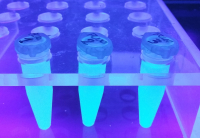 NEWS
NEWS
Fluorescent marine worms, software for protein binding propensity, and transdifferentiation of leukemic B-cells
Since many inventions remain unexploited due to the absence of an industry sponsor, or the lack of funding, the CRG established a Proof of Concept: Commercialization Gap Fund (CGF) in an effort to bridge the gap from research to commercialization. Now, three projects have been launched within the CGF.
Applications of the Commercialization Gap Fund (CGF) 2016 edition were evaluated by a committee consisting of two industry experts, two investors, a CRG group leader, and the Technology and Business Development team. From 6 initial applications, the evaluation committee selected 3 applications for funding.
Masha Plyuscheva, at the laboratory of ICREA research professor Fyodor Kondrashov, is leading a project aimed at characterizing newly, potentially fluorescent proteins, which she isolated from a marine parchment worm. These proteins may have a wide range of applications and important advantages over other existing fluorescent proteins.
ICREA research professor Gian Gaetano Tartaglia and his team, will validate experimentally, the predictive power of a new algorithm to estimate the binding propensity of protein-RNA pairs. The new algorithm, which is which is built on their previous algorithm CatRAPID, potentially provides a unique and effective software product to design novel molecules with therapeutic and/or diagnostic applications.
And, Thomas Graf and his group will try to establish a potential target pathway upstream a transcription factor, which induces transdifferentiation from leukemic B-cells into neutral, non-tumorgenic macrophages. He will also evaluate strategies to make the transdifferentiation process more efficient. This would facilitate the design of the most optimal screening strategy to identify potential transdifferentiation-inducing therapeutics in external collaborations.
About the Commercialization Gap Fund (CGF)
The Commercialization Gap Fund (CGF) is a TBDO initiative launched in, and an active program since, September 2015. The fund provides funding to bridge the gap between research and commercialization in the absence of an industry sponsor or investment partner. The fund aims to accelerate the commercialization of technologies developed at, or assigned to CRG, to move projects forward to a stage where they can be licensed to industry, investors or newly created spin-off companies.
The call for the 2017 CGF is now open. CRG scientists can submit their innovative proposals by October 1st. Please, find more information about this initiative and the 2017 call, here.

